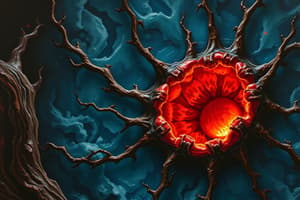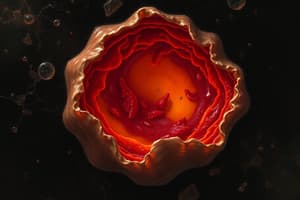Podcast
Questions and Answers
What is the role of active caspase 9 in apoptosis?
What is the role of active caspase 9 in apoptosis?
- To inhibit the tumor necrosis factor receptor
- To initiate the caspase proteolytic cascade (correct)
- To stimulate the expression of TNFR1
- To activate the Fas death receptor
What is the function of the death domain (DD) in TNFR?
What is the function of the death domain (DD) in TNFR?
- To activate the internal cell death program
- To interact with the death receptors to transmit the apoptotic signal (correct)
- To inhibit the caspase proteolytic cascade
- To stimulate the expression of FasL
What is the role of FADD in apoptosis?
What is the role of FADD in apoptosis?
- To contain the death domain to interact with death receptors (correct)
- To inhibit the expression of TNFR1
- To stimulate the expression of FasL
- To activate the internal cell death program
What is the result of the interaction between FasL and the Fas death receptor?
What is the result of the interaction between FasL and the Fas death receptor?
What is the function of caspases in apoptosis?
What is the function of caspases in apoptosis?
What is the mechanism of caspase activation?
What is the mechanism of caspase activation?
What is the role of T-cytotoxic cells in apoptosis?
What is the role of T-cytotoxic cells in apoptosis?
What is the difference between Fas and TNFR1 in apoptosis?
What is the difference between Fas and TNFR1 in apoptosis?
What is the function of the adaptor molecules FADD and TRADD?
What is the function of the adaptor molecules FADD and TRADD?
What is the role of the tumor necrosis factor receptor (TNFR) in apoptosis?
What is the role of the tumor necrosis factor receptor (TNFR) in apoptosis?
Flashcards are hidden until you start studying
Study Notes
Cell Death
- All cells eventually die by either necrosis or apoptosis.
Necrosis
- Passive, pathological process
- Induced by cellular injury or accidental means
- Often involves the simultaneous death of groups of cells
- Necrotic cells have ruptured cell membranes, causing cytoplasm and organelles to spill into surrounding tissue fluids
- Often induces an inflammatory response
Apoptosis
- Active, normal, physiological process
- Removes individual cells without damaging neighboring cells or inducing inflammation
- Cells have a characteristic "blebbed" appearance of their membranes
- Fundamental to cellular and tissue physiology, akin to cell division and differentiation
- Disturbances in apoptosis pathways may lead to cancers, autoimmune diseases, and neurodegenerative disorders
Characteristics of Apoptosis
- Cell shrinkage, but not lysis
- Plasma membrane remains intact, but portions bud off (blebbing)
- Phosphatidylserine in the inner membrane flips to the cell surface, serving as an "eat-me" signal to phagocytic cells
- Mitochondria releases cytochrome c in an ATP-dependent process, but remains within blebs
- Chromatin segments and condenses
Biological Significance of Apoptosis
- Removal of damaged cells
- Removes cells damaged beyond repair, infected, or starved, saving nutrition and preventing viral spread
- p53 protein halts cell cycle and stimulates apoptosis
- During development, apoptosis removes excess cells for normal development and function
- Selective apoptosis "sculpts" the developing tissues
- Incomplete apoptosis can result in abnormal structures
Initiation of Apoptosis
- Apoptosome (Internal Cell Death Program)
- Initiated by irreparable damage to cellular components or DNA
- Bax (proapoptotic protein) is inserted into the mitochondrial membrane, allowing cytochrome c to exit into the cytoplasm
- Cytochrome c in the cytosol triggers the formation of Apoptosome using ATP
- Cytoplasmic cytochrome c activates the apoptotic protease activating factor (Apaf-1) adaptor protein, which activates caspase 9
- Death receptor (External Cell Death Program)
- Triggered by death receptors (e.g., Fas, TNFR)
- Recognizes specific ligands, such as TNFR and Fas ligand
- Adaptor molecules (e.g., FADD, TRADD) interact with death receptors to transmit the apoptotic signal to the death machinery
Caspase Family of Proteases
- Stimulated to degrade cellular components in the apoptotic cell
- Proteases that are major effectors of apoptotic cell death
- Members of the cysteine protease class
- Synthesized as inactive zymogen or proenzyme forms and are activated to become functional proteases when needed
Studying That Suits You
Use AI to generate personalized quizzes and flashcards to suit your learning preferences.




